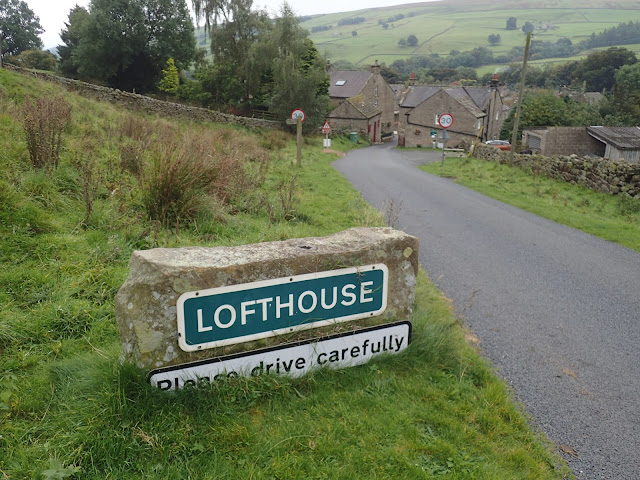
Fourteen of us including myself met on Sunday 8th October 2017 at Lofthouse Village Hall for the Beginners Lichens Day as part of the Upper Nidderdale Moorland Festival
 |
| First we examined the crustose lichens on the walls outside the hall |
 |
| Candelariella vitellina : This is the yellow lichen on the acid sandstone |
In some places, another yellow lichen:- Caloplaca citrina..
It was growing on mortar or where water had run over the mortar and then deposited limey material
 |
| Here I am sitting in the foreground testing the yellow lichen with KOH - Ah it goes crimson - It must be the Caloplaca. |
 |
| Ah this one has also turned red - It must be some more Caloplaca |
 |
| Porpidia tuberculosa |

Here is the Porpidia close up. The black line round the very edge is called the prothallus. The thallus (main body of the lichen) is arranged in areoles (tiny islands) with cracks in between. The blue grey marks are soralia - patches where the white skin (cortex) of the fungus allows the contents below to come out - powder made of fungal threads and algae.
We spent time in the hall looking at pictures on a screen and learning these names of parts of a lichen. Then keen not to loose the sunshine, we set off up all of 200m, up the hill outside the village.. carrying our lovely sandwich lunch that the festival had provided.
 |
| Lunch with a view up to Middlesmoor - Later we looked at the trees on the left. |


Lunch was relaxing. There were no lichens whatsoever amongst the grass of the grassland - though we did find three waxcap fungi (Hygrocybe punicea, nivalis and a yellow one) and a Liberty-cap
After lunch we examined the lichen of the trees and the wall

On the wooden electricity post in the picture I think we saw Hypocenomyces scalaris - need to get a photo of that . A few metres higher up behind us on the wall was Varicellaria (Pertusaria) lactea - Its white soralia go red with bleach
Varicellaria lactea
On the wall in the picture of the of the wall above are:-

T he green filamentous alga on the gritsone wall, in abundance is called Klebsormidium crenulatum. The darker brown areas - looking a bit like deposited mud are the lichen Acarospora fuscata. Both grow well where there is lots of reactive nitrogen
Yes there is a farm nearby - but you get this Klebsormidium growing on the wall right to the very tops of these hills, at the top of the Cote du Lofthouse.
 |
| Acarospora fuscata |
And below we have Parmelia saxatilis - called Crottle or Stony Rag in English

One person found some Stereocaulon vesuvianum. and we found several species of Cladonia and
and looked briefly at the welcome to Lofthouse sign
where there was more Candelariella vitellina (yellow remember?) and some Rhizocarpon reductum with the fruiting bodies growing in concentric circles

Then it was back to the village hall
Ah - but we had kept some of the Provisions for tea..

 |
| The participants stick some of the larger specimens to their charts with Copydex, and I show them Frank Dobson's book. |
RELEVANT LINKS
- post about the exploratory day I made for this trip here - with more pictures of lichens
- The provisional programme
- More posts on lichens in this blog
- Read a good article about Lofthouse here- The village that was nearly flattened
- and make sure you call in for delicious ice-cream made on the farm here, at the foot of the Cote de Lofthouse:
Meadowdale Icecream Facebookpage

Mint Meadowdale Ice-cream is a different green
to Rhizocarpon geographicum See if you can spot this yellow green Rhizocarpon geographicum - (Map Lichen) to the top right of the plaque.
to Rhizocarpon geographicum See if you can spot this yellow green Rhizocarpon geographicum - (Map Lichen) to the top right of the plaque.








No comments:
Post a Comment